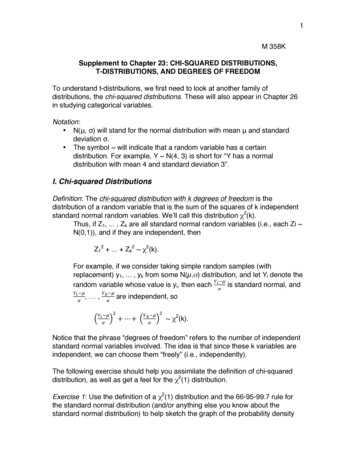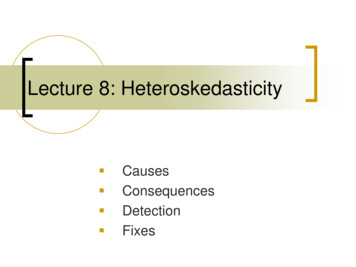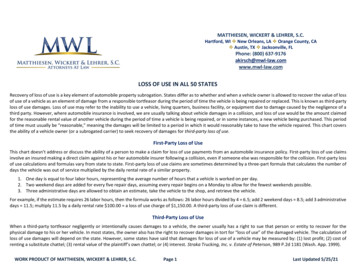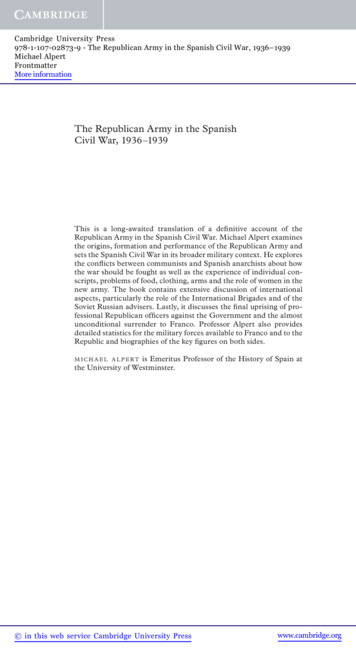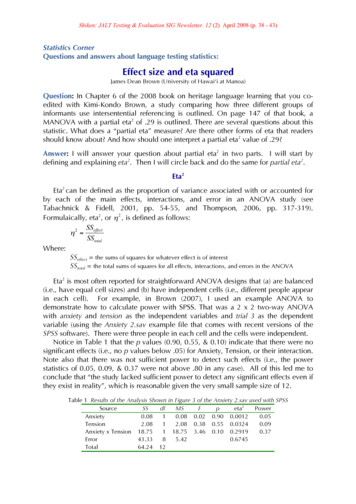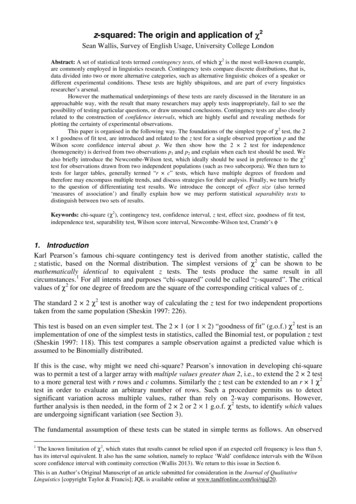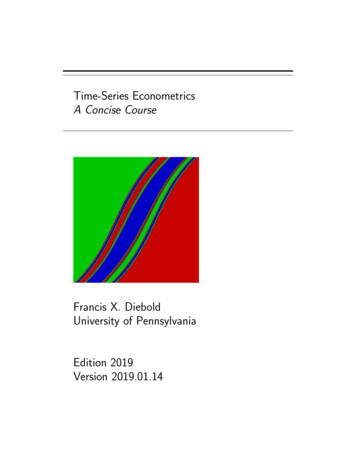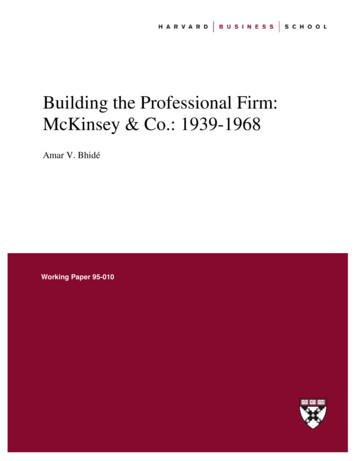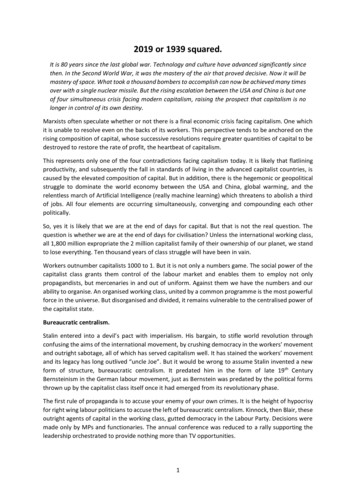
Transcription
2019 or 1939 squared.It is 80 years since the last global war. Technology and culture have advanced significantly sincethen. In the Second World War, it was the mastery of the air that proved decisive. Now it will bemastery of space. What took a thousand bombers to accomplish can now be achieved many timesover with a single nuclear missile. But the rising escalation between the USA and China is but oneof four simultaneous crisis facing modern capitalism, raising the prospect that capitalism is nolonger in control of its own destiny.Marxists often speculate whether or not there is a final economic crisis facing capitalism. One whichit is unable to resolve even on the backs of its workers. This perspective tends to be anchored on therising composition of capital, whose successive resolutions require greater quantities of capital to bedestroyed to restore the rate of profit, the heartbeat of capitalism.This represents only one of the four contradictions facing capitalism today. It is likely that flatliningproductivity, and subsequently the fall in standards of living in the advanced capitalist countries, iscaused by the elevated composition of capital. But in addition, there is the hegemonic or geopoliticalstruggle to dominate the world economy between the USA and China, global warming, and therelentless march of Artificial Intelligence (really machine learning) which threatens to abolish a thirdof jobs. All four elements are occurring simultaneously, converging and compounding each otherpolitically.So, yes it is likely that we are at the end of days for capital. But that is not the real question. Thequestion is whether we are at the end of days for civilisation? Unless the international working class,all 1,800 million expropriate the 2 million capitalist family of their ownership of our planet, we standto lose everything. Ten thousand years of class struggle will have been in vain.Workers outnumber capitalists 1000 to 1. But it is not only a numbers game. The social power of thecapitalist class grants them control of the labour market and enables them to employ not onlypropagandists, but mercenaries in and out of uniform. Against them we have the numbers and ourability to organise. An organised working class, united by a common programme is the most powerfulforce in the universe. But disorganised and divided, it remains vulnerable to the centralised power ofthe capitalist state.Bureaucratic centralism.Stalin entered into a devil’s pact with imperialism. His bargain, to stifle world revolution throughconfusing the aims of the international movement, by crushing democracy in the workers’ movementand outright sabotage, all of which has served capitalism well. It has stained the workers’ movementand its legacy has long outlived “uncle Joe”. But it would be wrong to assume Stalin invented a newform of structure, bureaucratic centralism. It predated him in the form of late 19th CenturyBernsteinism in the German labour movement, just as Bernstein was predated by the political formsthrown up by the capitalist class itself once it had emerged from its revolutionary phase.The first rule of propaganda is to accuse your enemy of your own crimes. It is the height of hypocrisyfor right wing labour politicians to accuse the left of bureaucratic centralism. Kinnock, then Blair, theseoutright agents of capital in the working class, gutted democracy in the Labour Party. Decisions weremade only by MPs and functionaries. The annual conference was reduced to a rally supporting theleadership orchestrated to provide nothing more than TV opportunities.1
This bureaucratic centralism is built into the modern capitalist state. This was exposed during theBrexit debacle. Taking control seemed to translate into control by the executive alone. Only thecabinet was involved in the discussion and decision making together with hand-picked senior civilservants. Parliament was reduced to agitated bystanders until they rebelled. Theresa May tried toelevate herself above the conflict of interests by monopolising the negotiations only to crash to theground in a pile of ineptitude.Bureaucratic centralism in the working class exists for two major and one minor reason. The two majorreasons are political while the minor reason is cultural. Firstly, bureaucratic centralism is the investableproduct of a party or organisation seeking to reconcile irreconcilable class antagonisms. Secondly,when the party or organisation is seen as the vehicle for personal advancement, an escalator so tospeak out of the working class and into the upper reaches of capitalist society. Finally, the minorreason results from a society which makes individuals competitive and insignificant leading to thedrive for self-recognition. We will only deal with the political side.The class contradictions in capitalist society are real and irreconcilable in the long term. But in theshorter term, particularly when economic conditions and productivity are in the ascendancy,concessions can be won, and reforms introduced. The British Labour Party and the Trade Unions existbased on these expectations. The leaders of both justify their positions by parading theirconcessionary trophies.The capitalists tolerate this situation. Their power derives from property rights, not from politicalcontrol as long as politics is not turned against them. They tolerate these leaders, this caste ofprivileged workers within the labour movement, because the small bargains they grant has theadvantage of deflecting the fight to abolish wage slavery itself.But what the capitalist class tolerates, a revolutionary working class will not - that is men and womenpaid multiple times the average workers’ salary, fixed in position, courted by the bourgeoisie whorecognise and support their utility of holding back the movement. These men and women fear aninsurgent working class more than the capitalist class, which is why the excel in mis-leadership.It is for this reason that they are adept at the dark arts of bureaucratic centralism. Of monopolisingthe structures of the organisation, controlling the dissemination of ideas and frustrating any rank andfile initiatives. In periods of heightened class struggle they thus play the role of a fifth column in theworking class.Again, in periods of heightened class struggle they fly false flags. They attack the left for undemocraticbehaviour when it is these bureaucrats who are tightening their bureaucratic grip on the organisationwith the aim of squeezing any opposition out of the organisation. They would rather see a defeat thenthe victory of the left. The scurrilous depths to which they can sink is staggering. This accusationagainst the left is predictably echoed by the tax dodging media who instinctively recognise that themachinations of these bureaucrats serve the interest of the employing class.But sometimes, the left is used in the interest of the bureaucracy. This is exemplified by Momentumin the Labour Party. The influx of new members potentiated a civil war in the Party as the hundreds ofthousands of new members clashed with the hundreds of bureaucrats. Momentum prevented thisdevelopment because it represented the capture of the left and its conversion into a controlledopposition within the Party. Of course, you would not have discovered this from the gutter press whopresented Momentum as this rampant movement of the left prepared to eat babies and to mixrecyclables with general waste. Director Lansman controlled the lines of communication, held secretmeetings to organise slates, handed down ready-made policies, and set the bar so high (5% of the2
membership had to agree a resolution before it even went forward) that resolutions could not beproposed or amended, in short, he behaved similarly to the worst right-wing bureaucrat. In the endthe membership of Momentum was converted into tech savvy canvassing fodder.Even in times of subdued class struggle this caste is still concerned to maintain office. They recognisethat their loss of office often means a return to poorly paid and unrecognised jobs. If they voluntarilyvacate their office they do so because invariably they have been ushered to the revolving door by agrateful private sector employer for services rendered.A minority can only rule a majority for any period of time with the help of agents in the working class,or what is the same thing, mis-leaders who seek to both deny and defy the historical interests of theworking class. In all cases this takes the form of bureaucratic centralism.Is decentralisation the answer.In response to bureaucratic centralisation, decentralisation has been put forward. Organisationscomposed of autonomous self-regulating functional groups are seen the way forward. This isexemplified by Extinction Resistance. Its constitution is eye opening.To understand XR’s mode of organising it is important to first understand Holacracy. “This system isinspired by and uses some features of Holacracy practice, and is also influenced by other methods ofself-organisation. It is important to understand that this is not Holacracy and that XR is not practicingHolacracy;” So XR’s systems are inspired by Holacracy but XR is not actually practicing Holacracy.Surely as question of having your cake and eating it too.How does the Holacracy organisation define itself: “Holacracy is a new way of structuring and runningyour organization that replaces the conventional management hierarchy. Instead of operating topdown, power is distributed throughout the organization, giving individuals and teams more freedomto self-manage, while staying aligned to the organization’s purpose.” The “your organisation” givesthe game away. It is directed towards the bosses of the organisation or its owners. It says here is abetter and more profitable way of running your company.Power is not distributed throughout the organisation. It is delegated power, power devolved fromabove. That is contained in the phrase, “more freedom, not complete freedom”. This freedom is limitedto function and purpose, in short refining processes with the firm and making them more responsive.Holacracy is a product of the Japanese onslaught on US corporations when lean production methods,just-in-time inventory control and teamwork upended many US and European corporations.Corporations such as Toyota selling high quality cheap cars seem unstoppable. In short it was arecognition that the old-style dehumanising assembly line could no longer cope with the complexityof production.Holacracy is not bottom up democracy but top down delegation. For this reason, it should not beconfused with actual workers’ democracy. Whatever aspects of self-management are granted, it doesnot include the right to elect managers, or set wages, or to set the intensity of labour, or hours, oremployment conditions or change product lines (when what is being produced is destructive). Thesepolicies, whether organisational, financial or marketing, the big circle remains firmly in the hands ofthe shareholders and directors who have but one purpose, to maximise profits. So, the big decisions,the strategic policies, continue to be made at the top. Let us give that a single name – policy. Workersare allowed to improve their oars, but the rudder remains firmly in hands of management, with theship’s papers in the pocket of the owners.3
As we shall see Holacracy, even the name is patented, permeates XR. This posting is completelydisinterested in the advantages set out by Holacracy in terms of streamlining organisations, but onlyto the bureaucratic danger it poses to the environmental movement through the denial of democracy.This can be seen at two levels. Firstly, policy and autonomy. Secondly, the ever-present facilitator.“A system which only has authority distributed into roles/circles could easily create chaos andfragmentation if there is nothing to constrain the distributed authority with and which createsalignment when needed; to prevent everyone just going off doing their own thing. A Policy is a specificexpectation which either grants or restrict authority outside of the mandates of roles/circles.” (6.Policies: to create constraints which limit the authority given to roles/circles by mandates) So readsthe clause in the constitution dealing with the relationship between policy and mandate so as to avoidchaos. Here we have it. The interplay between centralisation and decentralisation. Decentralisation isconstrained by centralisation, autonomy by policy.But who sets policy? Is it set by an unelected leadership feeding on feedback or is it to be set by themembership? Immediately we are hit by a problem. The membership is compartmentalised intosmaller “circles” and decision making is confined to these circles. They have no influence on the bigcircle which means policy decisions are out of reach.Nowhere is there found how the policy forum is established and how its’ members are elected. All wefind is a new appended clause, almost an afterthought, on how a policy committee should function.It’s the concept of the Anchor Circle. Mandate for the Anchor Circle (Clause 9) “. In other words, apolicy committee is in overall charge. The word Anchor is not without its irony, because it could alsomean that policy is anchored, fixed fast.If it consists of functionaries rather than elected members, it will become an anchor. Why is thisimportant? For two reasons. Because it is functional, it mitigates against diverse views. Secondly,because it is self-appointed, it is rigid and is likely to represent previous policies which thesefunctionaries promulgated and are joined to. Why is this important? There will come a time whenclass politics raises its head. The recognition, that the global catastrophe is a product of a system thatminimises costs in order to maximise profits, will come to the fore. That its solution goes way beyondgovernments declaring climate state of emergencies and owning-up the crisis. That thesegovernments will
2019 or 1939 squared. It is 80 years since the last global war. Technology and culture have advanced significantly since then. In the Second World War, it was the mastery of the air that proved decisive. Now it will be mastery of space. What took a thousand bombers to accomplish can now be achieved many times over with a single nuclear missile. But the rising escalation between the USA and .
